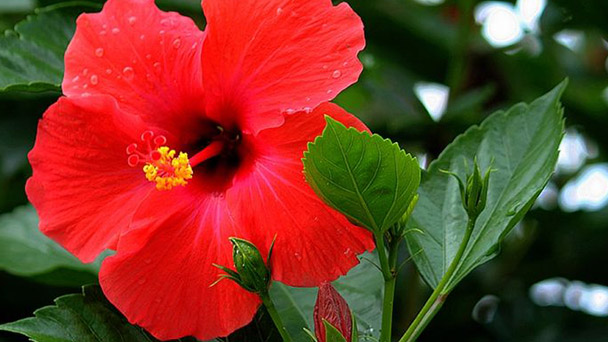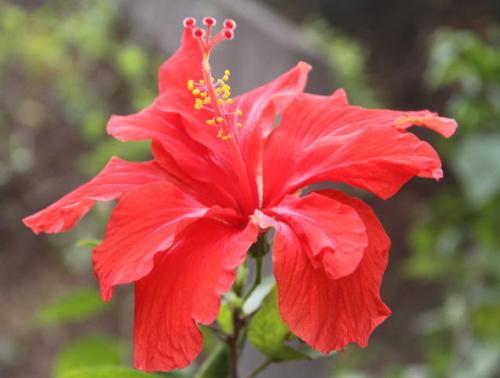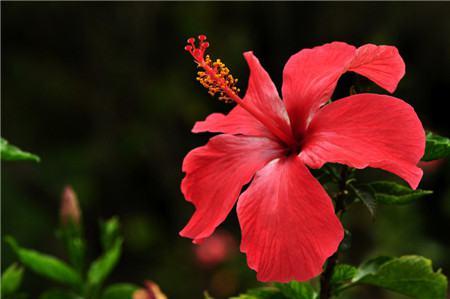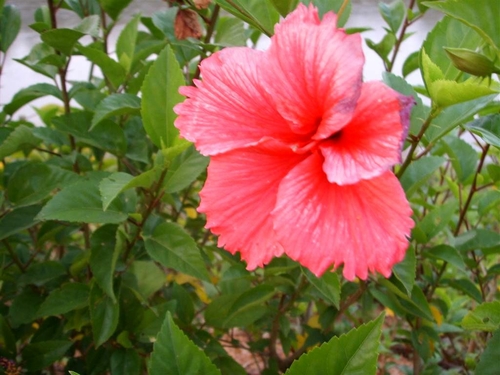Hibiscus rosa-sinensis profile
Written by Maggie
Nov 13 2020

Hibiscus rosa-sinensis is a famous Chinese flower and is very commonly cultivated in South China. The flowering period is long, almost endless all year round, the flowers are big and colorful, and the amount of blooming is large. In addition to simple management, it is an important greenhouse and indoor flower in the Yangtze River Basin and its north, in addition to the popular use of landscaping in subtropical areas. It can also be used for medicinal purposes.
Hibiscus rosa-sinensis picture

Morphological characteristics of Hibiscus rosa-sinensis
Hibiscus rosa-sinensis leaves similar to mulberry leaves, but also round leaves. Axillary trumpet-shaped flowers with single and double petals, with a maximum flower diameter of 25 cm, large evergreen shrubs or small trees. The stem is upright and branched, up to 6 meters high. The leaves are alternate, broadly ovate to narrowly ovate, 7-10 cm long, with 3 main veins, apex pointed or acuminate, leaf margins are thickly serrated or notched, bases are nearly entire, bald or dorsal veins are slightly sparse Hair, shaped like a mulberry leaf. The flowers are large, with drooping or straight-up stalks, solitary in the upper axillary, with single and double petals; single petals are funnel-shaped, double petals are non-funnel-shaped, red, yellow, pink, white, etc. Flowering throughout the year, most in summer and autumn.
The appearance of Hibiscus rosa-sinensis is passionate and bold, but it has a unique flower center, which is formed by connecting many small stamens and enclosing the big stamens. The structure is quite detailed, just like the slender heart under the warm appearance.
Hibiscus rosa-sinensis species classification
There are many varieties of Hibiscus rosa-sinensis, with more than 3,000 species in the world, with Hawaii being the most. There are not many varieties in our country. It is customary to use petals as the first level, flower color as the second level, and flower diameter as the third level. The varieties suitable for garden planting include small spin powder, mini white, flower on flower, pink peony, powder Xishi and other varieties, and bright red varieties suitable for potted plants.
Common species of Hibiscus rosa-sinensis
AmericanBeauty, the flower is deep rose red.
Aurantiacus, single petal, orange-red flower, with purple flower center.
Butterball, double petals, yellow flowers.
Butterfly, single petal, small flower, yellow.
CaliforniaGold, single petal, flower golden yellow, with deep red flower heart.
Cheerful, single petal, deep rose red, with white flower heart.
Cooperi, the leaves are long and narrow, lanceolate, green, with white, pink, and red markings. The flowers are small and bright red.
CrownofBohemia, double petals, the flower turns yellow to orange.
GoldenDust, single petal, orange, with orange yellow center.
HulaGirl, single petal, large flower, 15 cm diameter, yellow to orange-red, with crimson flower heart.
Lateritia, flower is orange-yellow, with black-red flower heart.
Lute, single petal, flower is orange yellow.
Matensis has red stems, gray-green leaves, single petals, magenta flowers, crimson veins and flowers.
Mist, double petals, large flowers, yellow.
President, single petal, flower is red, with a deep pink flower heart.
RedDragon, double petals, small flowers, deep red. Rose (Rosea), double petal, flower rose red.
Sundown, double petals, orange-red flowers.
Toreador, single petal, large flower, flower diameter 12-15 cm, yellow with red flower center.
Vulcan, single petal, large flower, red. White Wings (WhiteWings), single petals, large flowers, white.
Hibiscus rosa-sinensis growth environment
Hibiscus rosa-sinensis is native to southern my country. Like a warm and humid climate, not cold and frost resistant. It is not tolerant to shade and should grow in a sunny and ventilated place. The soil requirements are not strict, but it grows best in fertile, loose, slightly acidic soil, and the temperature in winter is not less than 5℃.
Hibiscus rosa-sinensis is a strong positive plant. It likes to be warm and humid in nature. It requires sufficient sunlight, intolerance to shade, intolerance to cold and drought. In the Yangtze River Basin and the north, it can only be planted in pots and kept in greenhouses or other protected areas for 12-15 ℃ temperature overwinter. The room temperature is below 5°C. The leaves turn yellow and fall off. If the temperature is lower than 0℃, it will suffer from freezing damage. Resistant to pruning and strong branching ability. It has a wide range of adaptation to the soil, but it grows best in slightly acidic loam rich in organic matter and pH 6.5 to 7.

Geographical distribution of Hibiscus rosa-sinensis
National Flower: Malaysia, Panama and the Republic of the Fiji Islands
State Flower: Hawaii
Origin: China
Hibiscus rosa-sinensis has a long history of cultivation in China.
There are many varieties of Hibiscus rosa-sinensis. They are divided into single petals and double petals according to the petals, and red, pink, yellow, blue, and white according to the flower color. Among them, the deep red double petals are slightly similar, not It is more common, so it is named hibiscus.
Hibiscus rosa-sinensis cultivar Hibiscus rosa-sinensis cv.Cooperi. is mainly for foliage viewing. The leaves have white, red, yellow, and green markings, which are very beautiful.

Latest Updated
- Benefits of Bugleweed - 7 Science-backed Health Benefits
- Bugleweed Dangers & Side Effects - Is It Poisonous?
- How to Plant Evergreen Trees - What You Should Know
- When to Plant Evergreens - Grow Guide for Evergreen Trees
- 12 Wonderful Evergreen Shrubs for Your Garden
- 12 Popular Evergreen Plants with Pictures for Beginners
- When And How To Prune A Lilac Bush Like a Pro
- How to Grow & Care for Lilac Vine (Hardenbergia Violacea)
- Japanese Lilac Tree (Syringa Reticulata) Care & Propagation Guide
- Shumard Oak Pros and Cons - What to Know
Popular Articles
- Winter maintenance of Antirrhinum Majus
- How to Grow Terminalia Mantaly Tree
- How to Grow and Care for Crossostephium Chinense
- How to grow Antirrhinum Majus in spring
- Peristeria Elata (Dove Orchid) Profile: Info & Care Guide
- Underwatered Snake Plant (Sansevieria Trifasciata) - Signs And How To Fix
- How to Care for Brazilian Jasmine Plant (Mandevilla Sanderi)
- How to Grow & Care for Graptopetalum Purple Delight in Summer
- Rosa Chinensis (China Rose): Plant Growing & Care Tips
- How to Care for Baby Sun Rose (Aptenia Cordifolia)